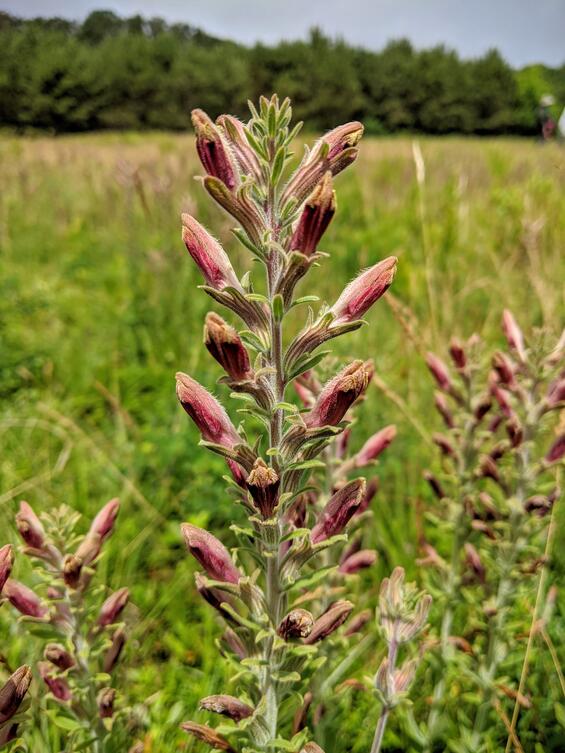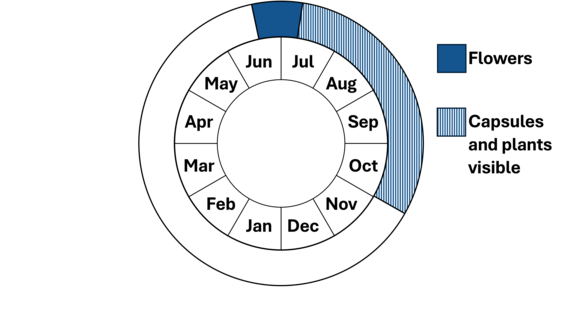- Scientific name: Schwalbea americana L.
- Species of Greatest Conservation Need (MA State Wildlife Action Plan)
- Endangered (MA Endangered Species Act)
- Endangered (US Endangered Species Act)
Description

American chaffseed in full flower.
American chaffseed (Schwalbea americana) is an herbaceous perennial from 30-56 cm (12-22 in) tall with alternate, yellow-green, untoothed, fuzzy leaves that grow between 2.5-5 cm (1-2 in) in length, usually growing in small clumps of 4 to 12 stems. The plant typically blooms in early July with loosely clustered 10-12 flowers toward the top of the stem. The flowers are about 4 cm (1.6 in) in length and 1 cm (0.4 in) in width and are composed of a tubular calyx (joined sepals) and tubular, two-lipped corolla (joined petals), both of which are covered with short hairs and have distinct striations running lengthwise. The overall shape of the flower is that of a narrow tube, expanding slightly from base to tip. The corolla color is pinkish-red and the calyx, a yellowish green, with several distinct, pointed lobes at the opening. The plant can be single-stemmed, or it can form a small, tight circle of 5-8 stems. Bumblebees force their way into the mostly closed tube of the corolla to pollinate the flower. Fruits are hard capsules that split open eventually along a line, revealing numerous tiny, lightweight seeds that can be airborne in a strong breeze.
American chaffseed is unlike almost any other plant. Studying a plant manual with good illustrations may be sufficient in being able to identify this plant correctly.
There is only one species in the genus Schwalbea and it is generally distinct from other members of the plant family Orobanchaceae (broomrape family) to which it belongs. This plant family consists of almost entirely parasitic plants that use structures to tap into the roots of other plants or fungal hyphae and draw on food resources or water supply or both. They often do have some chlorophyll and can produce some or most of their food through photosynthesis. Some have no chlorophyll at all and depend entirely on scavenged energy from other plants or fungi.
Life cycle and behavior
American chaffseed is an herbaceous perennial species that is a hemiparasite, drawing some resources from other plant species.

It flowers the last week of June through first two weeks of July. Capsules and plants visible through October.
Population status
American chaffseed is listed under the Massachusetts Endangered Species Act as Endangered. All listed species are protected from killing, collecting, possessing or sale, and from activities that would destroy habitat and thus directly or indirectly cause mortality or disrupt critical behaviors. In Massachusetts, American chaffseed is currently found only in Barnstable County and there is only one population. Previously, dating back to the 19th century, it was found in widely scattered locations in eastern Massachusetts as well as in Montague near the Connecticut River. The last population was seen on Cape Cod in 1965. However, a new and significant population was found in Barnstable County in 2018 and is being monitored and maintained.

Distribution in Massachusetts
1999-2024
Based on records in the Natural Heritage Database
Distribution and abundance
Massachusetts is the only state in New England with a current population of American chaffseed, where the species reaches its northeastern extent. It was found in Connecticut in the early 20th Century. The native range extends south, skipping over New York, New Jersey, Pennsylvania, Maryland, Delaware, and Virginia, with scattered populations in the Carolinas, and Georgia to Florida and west to Louisiana.
American chaffseed was given endangered status by the federal government in 1992 (U.S. Fish and Wildlife Service 2019). It is considered to be globally imperiled and in danger of extinction throughout its range. Further south, Schwalbea is generally only found in areas of frequent fire, such as a large military base in North Carolina where live artillery drills often catch the ground cover on fire which is left to burn. In South Carolina and Georgia, land managers working to restore habitat for bobwhite quail use prescribed burns on an annual or biannual basis, and in doing so, also help the maintain or increase some populations of American chaffseed.
Habitat
In Massachusetts, American chaffseed is found in sandplain grasslands, an open, sunny plant community often dominated by little bluestem grass (Schizachyrium scoparium). These are more common on Cape Cod and the islands on glacial outwash plains of sandy, nutrient-poor soil. Associated species include those typical of sandplain grasslands: little bluestem grass (Schizachyrium scoparium), yellow wild indigo (Baptisia tinctoria), lowbush blueberry (Vaccinium angustifolium), bayberry (Morella caroliniensis), hyssop-leaved boneset (Eupatorium hyssopifolium), flax-leaved aster (Ionactis linariifolia), Greene’s rush (Juncus greenei), hairy small-leaved tick-trefoil (Desmodium ciliare), pasture thistle (Cirsium pumilum), and gray and sweet goldenrod (Solidago nemoralis, S. odora).
This species has also been observed in association with other rare and uncommon plant species including the federally endangered sandplain gerardia (Agalinis acuta), narrow-leaved bush clover (Lespedeza angustifolia), northern blazing star (Liatris novae-angliae), Nuttall’s and racemed milkwort (Polygala nuttallii, P. polygama), post oak (Quercus stellata), and clasping-leaved milkweed (Asclepias amplexicaulis).
Healthy habitats are vital for supporting native wildlife and plants. Explore habitats and learn about conservation and restoration in Massachusetts.
Threats
Fire suppression, invasive species and succession to pitch pine forest all threaten the site. Invasive species include the shrub Elaeagnus umbellata (autumn-olive), which is difficult to treat and remove.
Conservation
Due to its federally endangered status, this species is monitored every year. This species needs open habitat and is one of the most fire-dependent herbaceous plant species in North America. The current population in Massachusetts is threatened by rapid growth of seedlings of pitch pine as well as invasive autumn olive (Elaeagnus umbellatus) which could quickly shade out this species. Invasive grasses are also present, such as sweet vernal grass, as well as common velvet grass. Prescribed fire would assist in a variety of ways to maintain this population but must be carefully planned and executed. Currently, annual mowing helps to keep the habitat open.Research is needed to best determine which associated plants are most beneficial to Schwalbea. Additionally, the effects of the timing and intensity of both mowing and prescribed fire should be actively researched. Finally, how is the species best propagated if additional populations are necessary to establish.
References
Haines, A. 2011. Flora Novae Angliae. Yale University Press, New Haven, CT. New England Wild Flower Society, Framingham, MA.
Graves, F.M. 1903. Schwalbea americana in Connecticut. Rhodora 49: 40–40.
Norden, A.H. 2002. Species biology and life history of the federally endangered Schwalbea americana L. (Scrophulariaceae). Masters Dissertation, University of Georgia, Athens.
Kirkman, L.K., M.B. Drew, and D. Edwards. 1998. Effects of experimental fire regimes on the population dynamics of Schwalbea americana L. Plant Ecology 137: 115–37. https://doi.org/10.1023/A:1008085229548.
Townsend, J.F. 1997. An unusual concentration of the federally endangered Schwalbea americana L. (Scrophulariaceae) in South Carolina. Castanea 62: 281–82.
U.S. Fish and Wildlife Service. 2019. American chaffseed (Schwalbea americana) 5-Year Review: Summary and Evaluation.
Contact
| Date published: | May 9, 2025 |
|---|